Abstract
Using the Hubbard representation for we write the time-evolution operator of a two-level system in the disentangled form. This allows us to map the corresponding dynamical law into a set of nonlinear coupled equations. In order to find exact solutions, we use an inverse approach and find families of time-dependent Hamiltonians whose off-diagonal elements are connected with the Ermakov equation. A physical model with the so-obtained Hamiltonians is discussed in the context of the nuclear magnetic resonance phenomenon.
1. Introduction
The dynamical manipulation of two-level systems has been a long-standing issue in quantum mechanics [,,]. In recent times, the problem has acquired more relevance due to its potential applications in quantum computing and quantum information [,,], where the design of robust and precise control protocols is essential. To this end, the analytically solvable, time-dependent problems in quantum mechanics are of great importance. However, it is well known that the solution of the Schrödinger equation with time-dependent Hamiltonians represents, in general, a difficult task and the number of exactly solvable cases is very limited. These include rotating fields [,], nonlinear modulated Rabi fields [], periodic driving fields [,], and pulse shaped fields []. Another method that has been widely used to generate exact solutions of the evolution equation concerns the inverse technique approach, where some aspects on the dynamics are prescribed and then the interactions are found. In [], for instance, some families of exactly solvable driving fields for spin-1/2 systems are obtained by requiring the spin to accomplish particular trajectories in the projective space. In [,,], on the other hand, this approach has been used to find analytical solutions for a two-level system driven by a single-axis control field.
Of particular interest in the solution of the evolution equation and in the generation of exactly solvable models is the Lie algebraic technique, which takes advantage of the fact that the Hamiltonian can be written as a linear combination of the generators of a Lie algebra [,,,,,,,]. In this scheme, the Wei Norman theorem establishes that the corresponding evolution operator can be factorized (or disentangled) into independent exponential factors involving only one generator of the algebra []. This technique has deserved a lot of interest as it is closely related to the group theoretical approach to the time evolution of quantum systems and has found a number of applications in the disentangling of exponential operators for the study of the dynamics of systems with and symmetries [,,,], as, e.g., the interaction of two-level atoms with electromagnetic radiation [], the field modulation in nuclear magnetic resonance [], the propagation and perfect transmission in three-waveguide axially varying structures [], the time-evolution of harmonic oscillators with time-dependent, both mass and frequency [,], the description of coherent and squeezed states [] and the optical coupling in nonlinear crystals [], among others. In a previous work, we show that the disentangling of the evolution operator is reduced to the solution of a scalar parametric oscillator-type equation, whose time-dependent frequency is given in terms of the driving field in a non trivial form []. Hence, the core difficulty in solving the problem lies in the fact that the solutions to the parametric oscillator-like equation can be explicitly written only in a restricted number of cases.
The aim of the present work is to obtain new families of analytically solvable driving fields in the framework of the Wei–Norman Lie algebraic approach and the inverse problem technique. Once the evolution operator is expressed in its disentangled form, the driving fields will be obtained by considering well known solutions to the corresponding parametric oscillator-type equation for a real-valued time-dependent frequency. It will be shown that, in this approach, the construction of the driving fields is accomplished by solving an Ermakov equation whose solutions can be readily expressed in terms of that of a parametric oscillator-like equation. In the statement of the direct approach, we consider the realization of the group constituted by the Hubbard operators (also called X-operators). These operators were introduced by Hubbard in [,,] and are useful to describe models of strongly correlated electrons. In addition, the algebraic properties of such operators allow for dealing with the observables of quantum systems in a suitable way [,]. For instance, a d-level system Hamiltonian can be diagonalized through a sequence of unitary transformations properly written in terms of Hubbard operators []. This method has been extended to the multipartite case by taking advantage of the Kronnecker product of the X-operators. The geometric measure of entanglement of a symmetric n-qubit is easily calculated in this approach [].
The paper is organized as follows. In Section 2, the statement of the problem and the direct approach are reviewed. The inverse problem and the main result of this work are reported in Section 3. In addition, a physical model concerning a spin 1/2-particle in a time-dependent external magnetic field is discussed in Section 4. Some concrete examples are analyzed in Section 5 where we show that our results generalize the case of a circularly polarized field and discuss some aspects of the dynamics such as the time-evolution of population inversion. Finally, the conclusions and perspectives of our work are presented in Section 6.
2. The Direct Approach
We are interested in the dynamics of systems whose Hamiltonians can be written in the form
where the operators are the generators of the algebra and , so that is Hermitian. For the two-dimensional representation, one obtains the Hamiltonian of a driven two-level system (or qubit). In this case, the constant is interpreted as the splitting between the two energy eigenvalues, while the complex-valued function V is the driving field that rules the transitions between the two energy states. A convenient realization of the group is constituted by the Hubbard operators as they provide a useful mathematical framework to deal with some calculations in a simpler way [,,], as well as to extend our formalism to the cases of qudits and multipartite systems.
In an n-dimensional vector space, the Hubbard or X-operators are defined as a set of two-labeled operators fulfilling the properties []
- (multiplication rule),
- (completeness),
- (non-hermiticity),
- (commutation rule),
where stands for the conventional commutator. The most elementary case arises for , for which it is possible to construct a representation of the Hubbard operators in the space of states of a two-level system. Indeed, if and are two orthonormal qubit states corresponding to the eigenvalues , , respectively, the four operators defined as
conforms a representation of the set of Hubbard operators in the space . Here, the subindex 2 is related to the dimension of the corresponding representation. Additionally, a simple calculation shows that the action of the operator (2) on the basis vectors reads
On the other hand, it is not difficult to verify that the three operators
constitute a representation of the algebra. Remark that, even though we are restricting ourselves to the representation of this algebra corresponding to , our results are equivalent for any value of j once the generators are written in the proper realization (see [] for details). The Hamiltonian (1) in terms of the X-operators reads
A discussion on a physical model associated to this operator is given in Section 4.
In the direct approach, once the driving field and the initial state are given, one must determine the state of the system at an arbitrary time according to
where is the time evolution operator associated to the Hamiltonian (5) fulfilling the dynamical law
with the initial condition . This operator can be cast in a factorized or disentangled form using the Wei–Norman theorem [], yet
where , f and are three factorizing complex-valued functions to be determined in such a way that . The action of the time-evolution operator (7) on the basis vectors can be straightforwardly computed by using the following relations []
Thus, if the qubit is initially, for instance, in the state , the state of the system at an arbitrary time reads
In Ref. [], it is shown that the solutions to the evolution problem (5)–(7) is given by
and
where the function , which will be also referred to as the driving field, has been introduced to shorten the notation. The function turns out to fulfill the parametric oscillator-like equation
with time-dependent frequency given by
Without having a loss of generality we may set , as the predictions will not depend on this initial value. In addition, the initial condition will fix the initial condition for the first derivative of in terms of and through
We emphasize that, given a particular driving field (or equivalently ), the problem of finding the time-evolution operator for the Hamiltonian (5) is turned into solving Equation (13). As it was mentioned before, the number of exactly solvable cases is limited as the form of the frequency (14) is in general non-trivial. Some exactly solvable cases are [], the circularly polarized field: [] and the hyperbolic secant pulse: [], just to mention some.
The aim of the next section is to explore the possibility of constructing new analytical solutions from the framework of the inverse approach.
3. The Inverse Approach
From the inverse problem technique point of view, a natural question at this point is what would be the form of a driving field giving rise to a particular well known solution of (13) fulfilling the proper initial conditions? In order to answer this question, we have to consider the expression (14) as a differential equation for the driving field, rather than a definition for the time-dependent frequency. First note that this equation is not of the Riccati-type in the function because of the term . Therefore, in order to transform this equation into a known one, let us consider the function defined by
It follows immediately that
In general, is a complex-valued function that can be split into its real and imaginary parts as . We will restrict ourselves to the case in which the function is real-valued. Under this assumption, the substitution of expression (17) into the Equation (14) leads to the set of equations
This last equation suggest that the function can be written in the form []
with k a real constant and a real-valued function. Indeed, it can be shown that Equation (18) can be reduced to an Ermakov equation choosing . In this case,
where is an integration constant and satisfies the Ermakov equation
The corresponding initial conditions for define the initial conditions on the driving field R as
where and . However, without loss of generality, we may fix . In this case, and
For reasons that will be clarified in the sequel, we call this quantity the generalized Rabi-like frequency.
Finally, inserting the functions and into the expression (17), we obtain the driving field in terms of the solutions of the Ermakov Equation (21)
This function defines a two-parametric family of exactly solvable time-dependent Hamiltonians of the form (5) with .
It is worthwhile to stress that the solutions to Equation (21) can be constructed provided that the solutions of (13) are known. Indeed, it can be shown that, if is a particular solution of such equation, then the function is given by [,]:
Here, and are integration constants [,] that can be determined from the initial conditions imposed on . Moreover, for the so-obtained Hamiltonians, the time-evolution operator is readily written from Equation (7) with the factorization functions and given by
where the real-valued function
has been introduced to shorten the notation.
Periodic Interactions
Of particular interest are the driving fields fulfilling the condition leading to the Floquet Hamiltonians or quasi-energy operators. Remark that a periodic function does not assure the periodicity of V. Indeed, if the period of the function is , it can be shown that
From this last expression, it is clear that, for V to be a periodic function, we should adjust and the parameters involved in the function in a very restrictive form. However, note that, for a natural number p, the following expression holds
This parameter p gives versatility to manipulate the period of the function V. Indeed, by requiring that
it is assured that V is a periodic function with period .
4. A Physical Model
In this section, we consider a quantum system whose Hamiltonian has the form (5) in terms of the Hubbard operators. Consider a spin-1/2 particle with magnetic moment in an external magnetic field , where and stand for the Bohr magneton and the Landé factor, respectively, and with , the Pauli matrices. The corresponding Hamiltonian reads
where is constant. We pay attention to the case where the field precesses around a fixed axis, say, the axis defined by . Thus, the magnetic field is written as , where is a constant and the driving field is used to manipulate the spin states of the particle. This field is represented schematically in Figure 1. In Hubbard notation, the Hamiltonian (32) is expressed as
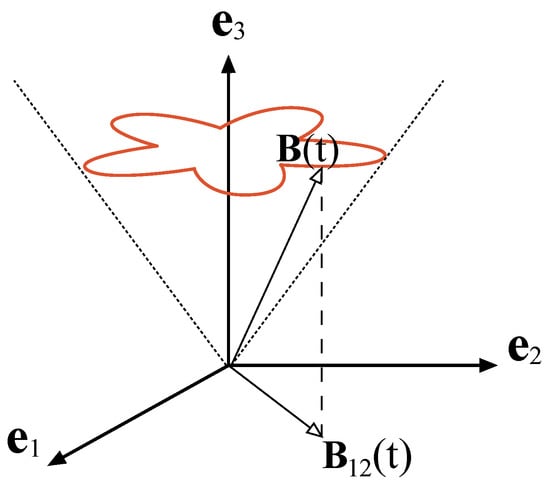
Figure 1.
Schematic representation of the magnetic field . The transversal component rotates around the axis in the plane . The amplitude of the driving field is time-dependent and describes a trajectory that in general is not closed. The circularly polarized field is a particular case of this expression when the amplitude is constant.
Thus, with the identification and , the Hamiltonian (33) takes the form (1). Note that the real and imaginary parts of the function V are proportional to the components 1 and 2 of the field, respectively. This justifies the name given to the function V. Although this model is valid in general, a particularly interesting exactly solvable problem arises whenever the transverse field has a constant amplitude . In addition, if we take and , being the oscillation frequency, then the transverse vector describes a circle in a plane transverse to and thus becomes a circularly polarized field. Hence and the solutions to the factorization problem (7) are easily constructed. We obtain where is a real constant, and the detuning . The factorization functions are (compare to []):
where is the Rabi frequency. If it is assumed that the system is initially in the state , then, according to expression (9), the state of the system at an arbitrary time can be computed to yield
In addition, the population inversion is also computed:
5. Some Simple Applications
In this section, we explicitly obtain some families of exactly solvable one-qubit time-dependent Hamilitonians for a given function . This function is chosen in such a way that the solutions to the parametric oscillator Equation (13) are known. The construction of the driving field through Equation (14) involves two arbitrary parameters, namely and (or equivalently and from Equation (25)) that fix the corresponding parameters and . We will discuss the case for which , with , analogous to the case of a circularly polarized field of the previous section. This choice leads to the simple conditions , and . We may also write , where g may be, in general, a complex constant. Thus, the driving field will be given in terms of the parameters and g.
We will consider that the frequency is a constant. In this case, two important limits are of interest. In the first one, the frequency , which leads to a decaying driving field. The second one arises as and corresponds to the problem of one qubit interacting with a single mode circularly polarized field.
5.1. Case : A Decaying Driving Field
On one hand, note that, when the frequency vanishes, the parametric oscillator Equation (13) becomes whose solution meeting the initial conditions (15) is . Next, the function can be found by taking in (25). The initial conditions and lead to and to the corresponding driving field
The factorizing functions and f can be explicitly constructed to yield
and
According to Equation (9), the time-evolution of the state can be computed in terms of the factorization functions as
Hence, the population inversion P is calculated as function of time
Figure 2 shows the function R in the complex plane for several values of the parameters g and . Remark that the real and imaginary parts can be considered as the transversal components of a control magnetic field. It can be seen from the driving field (37) that as , we have . This fact is noted in the population inversion P, which tends to a fixed value as time increases (see Figure 2)
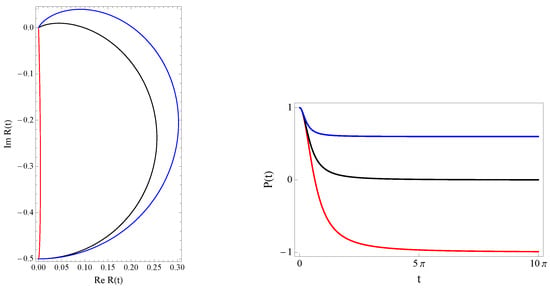
Figure 2.
(Left) the interaction term (37) in the complex plane; (Right) population inversion as a function of time. The parameters in both cases are: , (red), (black) and (blue).
5.2. Case : A Precessing Field with Oscillating Amplitude
A more general instance arises if the frequency is a real constant . With this choice, the parametric oscillator-like equation reduces to the conventional Newtonian harmonic oscillator equation
The solution that meets the initial conditions (15) reads
On the other hand, the solution (25) to the corresponding Ermakov equation can be constructed either with or with . After imposing the required initial conditions, we get
The corresponding driving field can be readily obtained
with
The interaction term (46) has the form of a precessing field with an oscillating amplitude. Note that a circularly polarized field is a particular case of our driving fields. Indeed, taking , we have and hence . Therefore, , which is the field discussed in Section 4.
On the other hand, note that the function (47) is well-defined in the interval as is continuous and hence Riemann integrable. In the Appendix A, we discuss the possibility of writing this integral in terms of elementary functions and also show that . This last result is useful to determine the conditions of periodicity of V. In fact, the period of the function is and, according to Equation (31), for , we must impose the condition that
is an even integer number in order to get a periodic driving field of period , p being the minimum natural number for which the former condition holds. Remark that, in this case, if , the periodicity of V also assures the periodicity of R. Some plots of the corresponding functions R are shown in Figure 3 for several values of , and g for which the periodicity condition holds. These describe a flower-like pattern which inscribes (circumscribes) a circle of radius when (). Additionally, an outer (inner) circle of radius bounds the oscillations amplitude. In both cases, the number p is related to the number of ‘petals’ of the field, that is to say, the number of times the function R reaches its maximum and minimum values in one period . On the other hand, in Figure 4, we have chosen the parameters so that the periodicity condition is not fulfilled, giving rise to open curves in the complex plane.
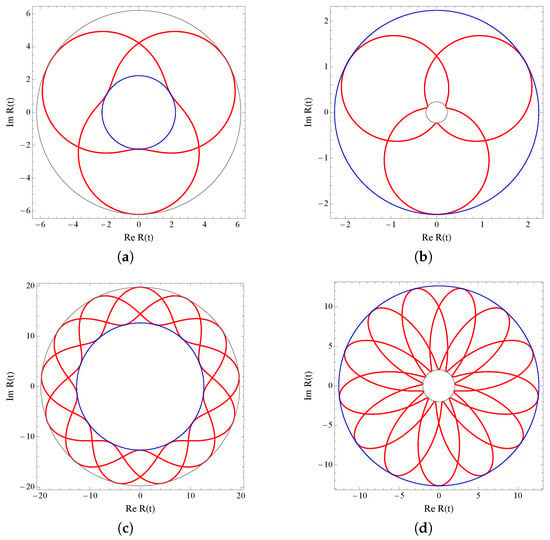
Figure 3.
The driving field (46) with and for (a) , and (b) , . In the lower graphics and , and (c) , and (d) , . The choice of the parameters grants the periodicity of V and R. The blue circle in all the cases corresponds to the case of a circularly polarized field and the gray one is the maximum (minimum) amplitude for ().
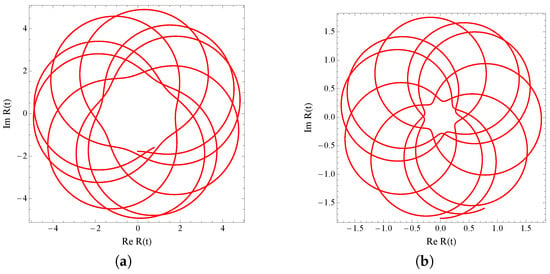
Figure 4.
The driving field (46) with , and (a) and (b) . These parameters do not fulfill the periodicity condition and the corresponding trajectories are not closed. In both cases, the time interval is .
Now, we can determine the evolution operator. Indeed, after some calculations, we find that the factorizing functions , f and take the form
where the functions , and are given in Equations (44), (45), and (47), respectively. Again, if the initial state is , the state of the system at an arbitrary time is
The population inversion as function of time can also be computed yielding
which is a periodic function of time with period . Remark that, for , the former expression retrieves the conventional expression (36) for the population inversion of a single qubit driven by a circularly polarized field. One can also note that regardless the value of , the population invertion (51) has local minima
which are achieved at times , with . In Figure 5, it is depicted the population inversion for several values of g and as well as for different values of . The blue-dashed curve corresponds to the case of a qubit interacting with a circularly polarized field (). It can be also seen that the period of oscillation for is shortened with respect to the case while it is enlarged for . On the other hand, in the limits and , the oscillations become more defined giving rise to a collapse-and-revival-like behaviour. This can be noted if one compares the shape of the oscillations shown in the plots (a) and (b) with those depicted in (c) and (d) of Figure 5, where we have set the value of according to the limits mentioned before. Finally, the parameters g and can be used to manipulate both the amplitude and shape of the oscillations on demand, as it is shown in Figure 6.
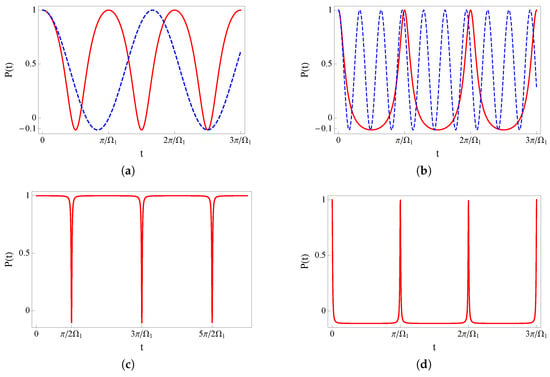
Figure 5.
Population inversion (51) as function of time. In the upper panels, the dashed line corresponds to the case of a qubit interacting with a circularly polarized field. In these plots, we have used (a) and (b) . In the lower plots, the function P shows a collapse-and-revival-like behavior for (c) and (d) . In all cases, we have taken and .
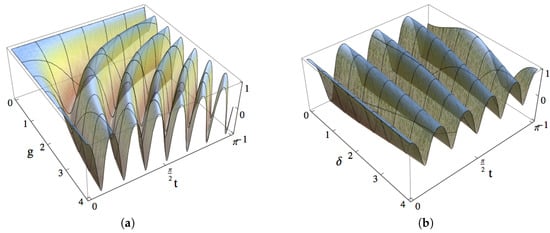
Figure 6.
Time-evolution of population inversion (51) as a function of the parameters (a) g and (b) , which can be used to manipulate the amplitude and period of the oscillations.
5.3. Case : A Precessing Decaying Driving Field
We now consider a pure imaginary constant frequency such that , with . In this case, the solutions to both the parametric oscillator-like Equation (13) and the Ermakov Equation (21) are given in terms of hyperbolic sine and cosine functions. This can be immediately seen from the fact that Equation (13) reduces to . The corresponding driving fields have analogous forms to those obtained in the previous case once the trigonometric functions in Equations (46) and (47) are interchanged by the corresponding hyperbolic ones. Accordingly, such control fields are no longer oscillating as they give rise to a decaying behavior in the atomic population inversion. A detailed analysis of this case will be reported elsewhere.
6. Conclusions
We have proposed a procedure to generate exactly solvable families of single qubit driving fields. Requiring that the corresponding time-evolution operator is written as a product of exponential operators, we find analytical solutions to the dynamical law using an inverse approach. The control fields are determined by means of the solutions of an Ermakov equation, which is obtained once the time-dependent frequency of the related parametric-oscillator equation is specified. The connection between these equations can be straightforwardly stated if such frequency is either a real-valued or a pure imaginary function of time. The dynamics of a qubit interacting with the so-obtained driving fields strongly depend on the form and the parameters of such a function. We have provided some examples of non-periodic and periodic control fields, as well as decaying fields for the case of a constant frequency. These results may shed some light in the problem of qubit control and the development of quantum gates. Some results on the construction of new solutions for the general case of a complex-valued frequency are in progress.
Author Contributions
M.E. proposed the main idea and the approach to the solution; Both authors discussed the results at all stages and contribute equally to the writing of the paper.
Funding
This research received no external funding.
Acknowledgments
The financial support of CONACyT, Instituto Politécnico Nacional, México (Project SIP20180377), the Spanish MINECO (Project MTM2014-57129-C2-1-P) and Junta de Castilla y León, Spain (VA137G18) is acknowledged. M.E. recognizes the support of Escuela de Ingeniería y Ciencias of Tecnológico de Monterrey.
Conflicts of Interest
The authors declare no conflicts of interest.
Appendix A. The Function η(t)
This Appendix is devoted to the search for a primitive of the function in for given in the expression (45). We first consider the function defined by the integral for t in the interval
The last equality can be easily shown by making the substitution
The initial condition allows us to conclude that . A similar procedure can be accomplished to evaluate an anti-derivative for t taking values in the interval . In addition, in order to ensure the continuity in the point , it is required that
Equation (A1) can be used to evaluate the right-hand side of the former condition. We find , and
Thus, the the function
is a primitive of in the interval . Finally, in order to find an antiderivative for this function in , a piecewise function must be defined for each subinterval with and the corresponding integrals can be evaluated in a similar form as in the previous case.
References
- Rabi, I. Space quantization in a gyrating magnetic field. Phys. Rev. 1937, 51, 652. [Google Scholar] [CrossRef]
- Zener, C. Non-adiabatic crossing of energy levels. Proc. R. Soc. A 1932, 137, 696. [Google Scholar] [CrossRef]
- Rosen, N.; Zener, C. Double Stern-Gerlac experiment and related collision phenomena. Phys. Rev. 1932, 40, 502. [Google Scholar] [CrossRef]
- Nielsen, M.A.; Chuang, I.L. Quantum Computation and Quantum Information; Cambridge University Press: Cambridge, UK, 2000. [Google Scholar]
- Gerardot, B.D.; Öhberg, P. A strongly driven spin. Science 2009, 326, 1489–1490. [Google Scholar] [CrossRef] [PubMed]
- Fuchs, G.D.; Dobrovitski, V.V.; Toyli, D.M.; Heremans, F.J.; Awschalom, D.D. Gigahertz dynamics of a strongly driven single quantum spin. Science 2009, 326, 1520. [Google Scholar] [CrossRef] [PubMed]
- Cruz, S.C.y.; Mielnik, B. Quantum control with periodic sequences of non resonant pulses. Rev. Mex. Fis. 2007, 53, 37–41. [Google Scholar]
- Bezvershenko, Y.V.; Holod, P.I. Resonance in a driven two-level system: Analytical results without the rotating wave approximation. Phys. Lett. A 2011, 375, 3936–3940. [Google Scholar] [CrossRef]
- Gangopadhyay, A.; Dzero, A.; Galitski, V. Exact solution for quantum dynamics of a periodically driven two-level system. Phys. Rev. B 2010, 82, 024303. [Google Scholar] [CrossRef]
- Xie, Q.; Hai, W. Analytical results for a monochromatically driven two-level system. Phys. Rev. A 2010, 82, 032117. [Google Scholar] [CrossRef]
- Vitanov, N.V. Complete population inversion by a phase jump: An exactly soluble model. New J. Phys. 2007, 9, 58. [Google Scholar] [CrossRef]
- Fernández, D.J.; Rosas-Ortiz, O. Inverse techniques and evolution of spin-1/2. Phys. Lett. A 1997, 236, 275–279. [Google Scholar] [CrossRef]
- Barnes, E.; Sarma, S.D. Analytically solvable driven time-dependent two-level quantum systems. Phys. Rev. Lett. 2012, 109, 060401. [Google Scholar] [CrossRef] [PubMed]
- Messina, A.; Nakazato, H. Analytically solvable Hamiltonians for quantum two-level systems and their dynamics. J. Phys. A Math. Theor. 2014, 47, 445302. [Google Scholar] [CrossRef]
- Dattoli, G.; Gallardo, J.; Torre, A. Time-ordering and solution of differential difference equation appearing in quantum optics. J. Math. Phys. 1986, 27, 772–780. [Google Scholar] [CrossRef]
- Dattoli, G.; Torre, A. SU(2) and SU(1,1) time-ordering theorems and Bloch-type equations. J. Math. Phys. 1987, 28, 618–621. [Google Scholar] [CrossRef]
- Dattoli, G.; Richetta, M.; Torre, A. Evolution of SU(2) and SU(1,1) states: A further mathematical analysis. J. Math. Phys. 1988, 29, 2586–2588. [Google Scholar] [CrossRef]
- Dattoli, G.; Gallardo, J.C.; Torre, A. An algebraic view to the operatorial ordering and its applications to optics. La Rivista del Nuovo Cimento 1988, 11, 1–79. [Google Scholar] [CrossRef]
- Campolieti, G.; Sanctuary, B.C. The Wei–Norman Lie-algebraic technique applied to field modulation in nuclear magnetic resonance. J. Chem. Phys. 1989, 91, 2108–2123. [Google Scholar] [CrossRef]
- Prants, S.V. A group-theoretical approach to study atomic motion in a laser field. J. Phys. A Math. Theor. 2011, 44, 265101. [Google Scholar] [CrossRef]
- Kenmoe, M.B.; Fai, L.C. Wei–Norman-Kolokolov approach for Landau-Zener problems. J. Phys. A Math. Theor. 2014, 47, 465202. [Google Scholar] [CrossRef]
- Enríquez, M.; Cruz, S.C.y. Disentangling the time-evolution operator of a single qubit. J. Phys. Conf. Ser. 2017, 839, 012015. [Google Scholar] [CrossRef]
- Wei, J.; Norman, E. Lie algebraic solution of linear differential equations. J. Math. Phys. 1963, 4, 575–581. [Google Scholar] [CrossRef]
- Rodríguez-Lara, B.M.; Moya-Cessa, H.M.; Christodoulides, D.N. Propagation and perfect transmission in three-waveguide axially varying couplers. Phys. Rev. A 2014, 89, 013802. [Google Scholar] [CrossRef]
- Datolli, G.; Solimeno, S.; Torre, A. Algebraic time-ordering technics and harmonic oscillator with time-dependent frequency. Phys. Rev. A 1986, 34, 2646. [Google Scholar] [CrossRef]
- Lo, C.F. Squeezing in harmonic oscillator with time-dependent mass and frequency. Il Nuovo Cimento B 1990, 105, 497–506. [Google Scholar] [CrossRef]
- Cheng, C.M.; Fu, P.C.W. The evolution operator technique in solving the Schrödinger equation, and its application to disentangling exponential operators and solving the problem of a mass-varying harmonic oscillator. J. Phys. A Math. Gen. 1988, 21, 4115. [Google Scholar] [CrossRef]
- Croxson, P. Time dependent quadratic Hamiltonians SU(2) and SU(2, 1). Phys. Lett. A 2006, 355, 12–17. [Google Scholar] [CrossRef]
- Hubbard, J. Electron correlations in narrow energy bands. Proc. R. Soc. Ser. A 1963, 276, 238–257. [Google Scholar] [CrossRef]
- Hubbard, J. Electron correlations in narrow energy bands. II. The degenerate band case. Proc. R. Soc. Ser. A 1964, 277, 237–259. [Google Scholar] [CrossRef]
- Hubbard, J. Electron correlations in narrow energy bands-IV. The atomic representation. Proc. R. Soc. Ser. A 1965, 285, 542–560. [Google Scholar] [CrossRef]
- Enríquez, M.; Rosas-Ortiz, O. The Kronecker product in terms of Hubbard operators and the Clebsch-Gordan decomposition of SU(2) × SU(2). Ann. Phys. 2013, 339, 218. [Google Scholar] [CrossRef]
- Enríquez, M. Hubbard operators in multiqubit systems. J. Phys. Conf. Ser. 2016, 624, 012019. [Google Scholar] [CrossRef]
- Enríquez, M. On the eigenvalue problem in multipartite quantum systems. J. Phys. Conf. Ser. 2016, 698, 012021. [Google Scholar] [CrossRef]
- Rosas-Ortiz, O.; Casta nos, O.; Schuch, D. New supersymmetry-generated complex potentials with real spectra. J. Phys. A Math. Theor. 2015, 48, 445302. [Google Scholar] [CrossRef]
- Ermakov, V.P. Second order differential equations. Conditions to complete integrability. Kiev Univ. Izvestia Ser. III 1880, 9, 125. (In Russian) [Google Scholar] [CrossRef]
- Pinney, E. The nonlinear differential equation y″ + p(x)y + cy-3 = 0. Proc. Am. Math. Soc. 1950, 1, 681. [Google Scholar] [CrossRef]
© 2018 by the authors. Licensee MDPI, Basel, Switzerland. This article is an open access article distributed under the terms and conditions of the Creative Commons Attribution (CC BY) license (http://creativecommons.org/licenses/by/4.0/).